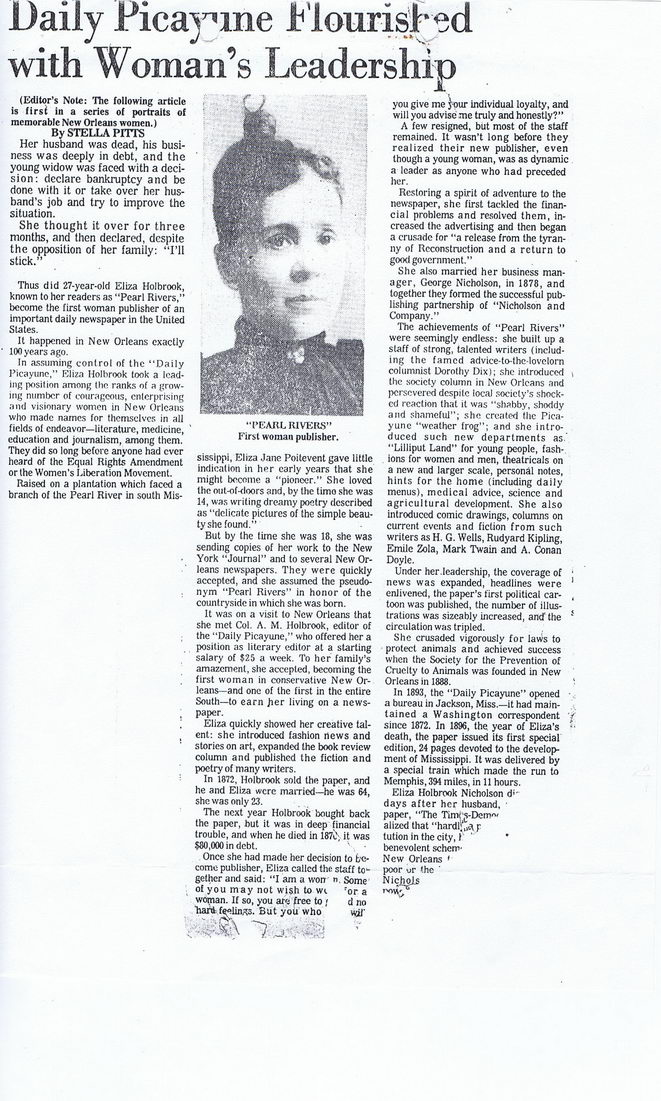This text was obtained via automated optical character recognition.
It has not been edited and may therefore contain several errors.
with Woman?s
(Editor?s Note: The following article is first in a series of portraits of memorable New Orleans women.)
By STELLA PITTS
Her husband was dead, his business was deeply in debt, and the young widow was faced with a deci-sion: declare bankruptcy and be done with it or take over her husband?s job and try to improve the situation.
She thought it over for three months, and then declared, despite the opposition of her family: ?I?ll stick.?
Thus did 27-year-old Eliza Holbrook, known to her readers as ?Pearl Rivers,? become the first woman publisher of an important daily newspaper in the United States.
It happened in New Orleans exactly 100 years ago.
In assuming control of the ?Daily Picayune,? Eliza Holbrook took a leading position among the ranks of a growing number of courageous, enterprising and visionary women in New Orleans who made names for themselves in all fields of endeavor?literature, medicine, education and journalism, among them. They did so long before anyone had ever heard of the Equal Rights Amendment or the Women?s Liberation Movement.
Raised on a plantation which faced a branch of the Pearl River in south Mis-
?PEAJIL RIVERS?
First woman publisher.
sissippi, Eliza Jane Poitevent gave little indication in her early years that she might become a ?pioneer.? She loved the out-offloors and, by the time she was 14, was writing dreamy poetry described as ?delicate pictures of the simple beauty she found.?
But by the time she was 18, she was sending copies of her work to the New York ?Journal? and to several New Orleans newspapers. They were quickly accepted, and she assumed the pseudonym ?Pearl Rivers? in honor of the countryside in which she was born.
lt was on a visit to New Orleans that she met Col. A. M. Holbrook, editor of the ?Daily Picayune,? who offered her a position as literary editor at a starting salary of $25 a week. To her family?s amazement, she accepted, becoming the first woman in conservative New Orleans?and one of the first in the entire South?to earn her living on a newspaper.
Eliza quickly showed her creative talent: she introduced fashion news and stories on art, expanded the book review column and published the fiction and poetry of many writers.
In 1872, Holbrook sold the paper, and he and Eliza were married?he was 64, she was only 23.
The next year Holbrook bought back the paper, hut it was in deep' financial trouble, and when he died in 1870', it was $80,000 in debt. ?
Once she had made her decision to b'e* come publisher, Eliza callcd the staff together and said: ?I am a won' n, Some? of you may not wish to w<. ror a
woman. If so, you ar^' free to / d no
Tiari fewlinfts. But you? who wif
you give me }our individual loyalty, and will you advise me truly and honestly??
A few resigned, but most of the staff remained. It wasn?t long before they realized their new publisher, even though a young woman, was as dynamic a leader as anyone who had preceded her.
Restoring a spirit of adventure to the newspaper, she first tackled the financial problems and resolved them, increased the advertising and then began a crusade for ?a release from the tyranny of Reconstruction and a return to good government.?
She also married her business manager, George Nicholson, in 1878, and together they formed the successful publishing partnership of ?Nicholson and Company.?
The achievements of ?Pearl Rivers? were seemingly endless: she built up a staff of strong, talented writers (including the famed advice-to-the-love lorn columnist Dorothy Dix); she introduced the society column in New Orleans and persevered despite local society?s shocked reaction that it was ?shabby, shoddy and shameful?; she created the Picayune ?weather frog?; and she introduced such new departments as.' ?Lilliput Land? for young people, fashions for women and men, theatricals on a new and larger scale, personal notes, hints for the home (including daily menus), medical advice, science and agricultural development. She also introduced comic drawings, columns on current events and fiction from such writers as H. G. Wells, Rudyard Kipling, Emile Zola, Mark Twain and A. Conan Doyle.
Under her.leadership, the coverage of news was expanded, headlines were enlivened, the paper?s first political cartoon was published, the number of illustrations was sizeably increased, and' the circulation was tripled.
She crusaded vigorously for laws to protect animals and achieved success when the Society for the Prevention of Cruelty to Animals was founded in New Orleans in 1888.
In 1893, the ?Daily Picayune? opened a bureau in Jackson, Miss.?it had maintained a Washington correspondent since 1872. In 1896, the. year of Eliza?s death, the paper issued its first special edition, 24 pages devoted to the development of Mississippi. It was delivered by a special train which made the run to Memphis, 394 miles, in 11 hours.
Eliza Holbrook Nicholson df-days after her husband, ? paper, ?The Tim{?<5-Dem?' alized that ?hardl^A f tution in the city, 1 ' *
benevolent schem-New Orleans * poor ur the '
Nichols
V. . V r T

Pearl Rivers Daily Picayune Fllourished with Women's Leadership